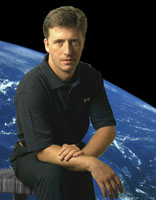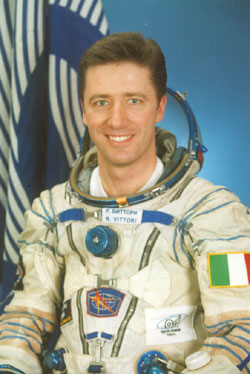
.

 |
|
 |
|
| RSC
Energia bio
(Apr 02) |
 Roberto
VITTORI Roberto
VITTORI
Flight Engineer 1 of Soyuz TM-34
DATE AND PLACE OF BIRTH: October 15, 1964, Viterbo, Italy. EDUCATION: Graduated from the Italian Air Force Academy in 1989. Completed
basic training with the US Air Force at Reese Air Force Base in Texas,
US, in 1990. Graduated from the US Navy Test Pilot School in 1995. Completed
the Italian Air Force's Accident Prevention course (Guidonia A.F.B., Italy)
and Accident Investigation course (Kirtland A.F.B., New Mexico, US) between
1996 and 1997.
FAMILY STATUS: married.
AWARDS AND RANKS: Academic award for completion of training at Reese Air Base, Texas. Honorary student of the Test Pilot School in Patuxent River, Maryland. Honorary student of the US Flight Safety School, Kirtland Air Force Base, New Mexico. Long Service medal from Italian Air Force (1997). HOBBIES: soccer, jogging, swimming, reading. WORK EXPERIENCE: From 1991 to 1994 he flew Tornado GR-1 aircraft as
a member of squadron 155, regiment 50, Piacenza, Italy. During that period
he completed training on in-flight refueling both during daytime and at
night and was assigned to be a formation leader.
April 2002.
|
| RSC
Energia bio
(Mar 05) |
 Roberto
VITTORI Roberto
VITTORI
Flight Engineer of Soyuz TMA
DATE AND PLACE OF BIRTH: October 15, 1964, Viterbo, Italy. EDUCATION: Graduated from the Italian Air Force Academy in 1989. Completed basic training with the US Air Force at Reese Air Force Base in Texas, US, in 1990. Graduated from the US Navy Test Pilot School in 1996. Completed the Italian Air Force's Accident Prevention course (Guidonia A.F.B., Italy) and Accident Investigation course (Kirtland A.F.B., New Mexico, US) between 1996 and 1997. FAMILY STATUS: married to Valeria Vittori, born Nardi, has three children. AWARDS AND RANKS: Academic award for completion of training at Reese Air Base, Texas. Honorary student of the Test Pilot School in Patuxent River, Maryland. Honorary student of the US Flight Safety School, Kirtland Air Force Base, New Mexico. Long Service medal from Italian Air Force (1997). HOBBIES: soccer, jogging, swimming, reading. WORK EXPERIENCE: From 1991 to 1994 he flew Tornado GR-1 aircraft as
a member of squadron 155, regiment 50, Piacenza, Italy. During that period
he completed training on in-flight refueling both during daytime and at
night and was assigned to be a formation leader.
March 2005.
|
|